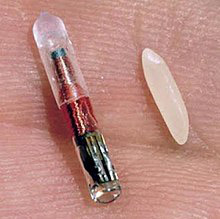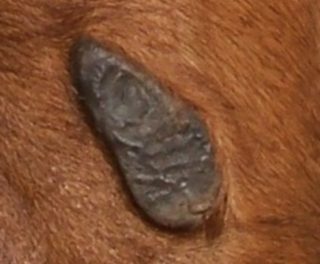THE WAY OF HORSES
 Many years ago Don sent a good race-bred Quarter Horse mare to a stallion for breeding. Unbeknownst to Don the owner of the stallion and his wife were going through a bitter divorce. One night the embittered wife had every horse on the property loaded up and taken to auction. By the time Don was informed (this was before the advent of cell phones and text messaging) the horses were gone.
Many years ago Don sent a good race-bred Quarter Horse mare to a stallion for breeding. Unbeknownst to Don the owner of the stallion and his wife were going through a bitter divorce. One night the embittered wife had every horse on the property loaded up and taken to auction. By the time Don was informed (this was before the advent of cell phones and text messaging) the horses were gone.
Don’s good mare was sorrel, with no white markings, no brand and no identifying scars. It was like looking for the proverbial needle in the haystack. The mare was never located.
Identifying horses has always been a challenge. Physical description, branding and tattooing have been the common methods of horse identification, but each has its drawbacks. When identifying a horse based on color and markings a person could be talking about thousands of horses with the same description. Brands are generally not unique to each horse, can be difficult to read, or be altered. Lip tattoos are also difficult to read, can be altered and fading is a problem.
A more reliable method of identification is microchipping. Microchips used for identifying dogs and cats have been around for years, and they are beginning to gain popularity with horse owners.
Microchips used for identification emit a radio frequency signal which is activated when a scanner is passed over it. The scanner reads the unique code that the owner has registered with a database company. The database will have information leading to the person who registered the chip.
Microchips are available in three radio frequencies:
1. 125 kHz – this frequency has been available in the United States for the longest and is the most common. Most scanners will read this frequency.
2. 129 kHz – this frequency became available in 2007, and not all scanners will read the chip.
3. 134.2 kHz – this frequency meets the specifications mandated by the International Standards Organization (ISO 11784/11785). These chips use a 15-digit numeric code, with the first three digits designating either the country, or the manufacturer. The remaining numbers are unique to the horse in which the chip was implanted. Older scanners will not read the 134.2 kHz frequency.
The range of frequencies available for identification is cause for concern – if the scanner used is not capable of picking up the frequency the chip will not be detected. No governing body in the United States has set a mandatory standard for microchip production.
In 1996 the American National Standards Institute (ANSI) voted to adopt the International Standards Organization’s specifications of the 134.2 kHz chip (ISO 11784/11785) as their recognized chip. The American Veterinary Medical Association (AVMA), American Animal Hospital Association (AAHA), World Small Animal Veterinary Medical Association (WSAVA), and American Society for the Prevention of Cruelty to Animals (ASPCA) endorse the use of electronic identification in animals and support the use of the ISO standard 11784/11785 in the U.S.
Several equine organizations have implemented mandatory use of the ISO 11784/11785 microchip. The Jockey Club is mandating all 2017 and subsequent Thoroughbred foal crops are to be implanted. By 2019 all horses competing in United States Hunter Jumper Association competitions must be chipped with the ISO 11784/11785 chip. The Fédération Equestre Internationale (FEI) requires all horses registered after January 2, 2013 to be implanted.
Louisiana is the only state which requires mandatory identification of all horses receiving a Coggins test. The identification could be brands, tattoos or microchips. Chipping is the most used method. In 1994, when Hurricane Katrina hit Louisiana, 363 out of the 364 lost horses were reunited with their owners.
The microchip is relatively easy and inexpensive to implant. The chip is approximately the size of a grain of rice, which is inserted in the nuchal ligament between the poll and withers by a veterinarian. Most horses can be implanted without the use of a sedative, and adverse reactions are rare. The cost is about $75.00.
Incorrect implantation of the microchip can cause severe and potentially life-threatening complications, and should only be inserted by a qualified veterinarian. Proper placement in the neck muscle will also lessen the chances of the chip migrating to a different location.
Once the microchip is implanted, it must be registered. There is no centralized database in the United States. There are several independent registries, and owners are encouraged to register and update information at these, along with registering with the company who manufactured the microchip.
In an attempt to bring order to the chaos, the American Animal Hospital Association operates the AAHA Universal Pet Microchip Lookup Tool (http://www.petmicrochiplookup.org/). Several of the independent registries have linked to the AAHA tool, but it is highly recommended to register on multiple databases, as not all manufacturers participate in every database. For example, AVID Pet Microchips does not participate in the AAHA lookup tool, but they operate their own database (https://avidid.com/). AAHA will point you to the AVID website for information.
Horse and pet owners should conduct research into the company providing the microchip before implanting the chip. There are five big companies, PetLink, Home Again, AKC Reunite, AVID and 24 Petwatch – each of these companies have been assigned source codes (the first three digits in the 15-digit number of the ISO 11784/11785 chip). This enables the person scanning the chip to identify the company and access the registry, making the process of finding the owner more expedient. Smaller companies share assigned 900 numbers, which cannot be tracked to the specific company. There is also the risk of implanting inferior quality chips (made in China) when purchasing from small companies.
In January 2017 the National Institute for Animal Agriculture held a forum discussing equine identification. The results can be viewed at: http://www.animalagriculture.org/proceedings/equineidforum
Microchipping your horse may not guarantee the return of your horse if you and he should become separated, but it can increase the odds. Debi Metcalfe, of Stolen Horse International, Inc., recommends in addition to the microchip, every horse should have a packet which includes: a bill of sale; photos of your horse looking clean and dirty; photos of your horse (with you in the picture) that clearly show all markings; photos of brands, whorls, scars and identifying markings; copies of veterinary records and proof of payment.
Metcalfe continues, “Put all those copies in an envelope and mail it to yourself. When you receive it, don’t open it, but place it in a safe place that’s easily accessible. That way, you will have proof of ownership with a clearly dated chain of custody. If you have microchipped your horse, that’s the extra piece that can make a difference if you ever become separated from your horse through theft, disaster, or your horse just gets loose and goes missing.” Please visit: http://www.netposse.com/ for more information about Stolen Horse International, Inc. (They also offer microchip kits for horses and pets at affordable prices.)
After having your horse microchipped be sure to register your horse with the NetPosse Identification Program (NIP) Registry maintained by Stolen Horse International, Inc. https://netposse.com/article.asp?id=2131
* You can get a Bachelor of Science degree in Equine Studies or certification as a Professional Horse Trainer or Riding Instructor online. Visit www.horsecoursesonline.com for information.




